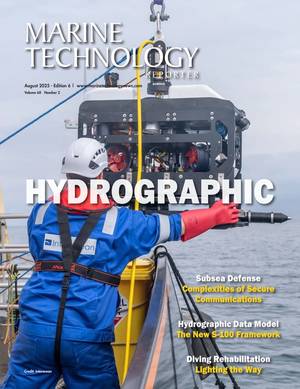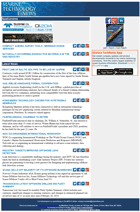
NATO RV Alliance is not just quiet, it’s ice-capable
An interview with Ian Sage, director for marine operations, NATO Center for Maritime Research and Experimentation, La Spezia, Italy.NATO’s 3,100-ton, 305-foot research vessel NRV Alliance has been a leading platform for underwater acoustics research to the benefit of NATO navies. The ship operated with a civilian crew under the German flag for many years for the NATO SACLANT Center, later renamed the NATO Undersea Research Center, and now known as the NATO Center for Maritime Research and Experimentation. Now Alliance flies a new flag, and has a broader mission. What’s

NATO employs MUSCLE Memory to Find Mines
;s exactly what MUSCLE is,” said Rob Been, deputy head of CMRE’s engineering. Division. “We’ve had the Bluefin-21 for quite a long time. And over the years, with the collaboration of Bluefin, we have made it more modular.”The MUSCLE and BLACK CAT UUVs on board NRV ALLIANCE prior to participation in GAMEX’17. (Photo: NATO CMRE)MUSCLE and BLACK CAT in GAMEX ’17 Exercise)Been said CMRE started off with a Bluefin with an integrated synthetic aperture sonar that had the ability to follow pre-programmed waypoints record data. “We would have to

NATO Science Mission Employs ‘Double Muscle’
on her first NATO sea trial of the year, the NATO research vessel (NRV) Alliance has sailed out with new assets on board that aim to enhance collaborative robotics for MCM applications, including a new vehicle, which only apparently duplicates the CMRE MUSCLE prototype. On the aft deck of the NRV Alliance, sailing for the first CMRE (Centre for Maritime Research and Experimentation) scientific campaign of 2017, there are two very similar robots. One is the MUSCLE vehicle, a reliable prototype developed by CMRE for seabed mapping with automatic behavior capabilities. The other is not just a twin

CMRE, NOAA Partner for Atlantic Ocean Monitoring
, has proved to be particularly well-suited to this mission. In this context, NOAA Vice Admiral Michael S. Devany, Deputy Under Secretary for Operations at NOAA, and Rear Admiral (Rtd.) Hank Ort, CMRE Director, signed a five-year framework agreement to facilitate research vessel support from NRV Alliance in particular, with monitoring of meteorological, hydrological, and oceanographic processes, bathymetry, and climate. The collaboration marks a breakthrough in transatlantic cooperation while fostering sharing of assets and capabilities in the North Atlantic. “CMRE is proud to serve

CMRE Leads Large Glider Experiment
CMRE leads large glider experiment in the Sardinian Sea to enhance Environmental Knowledge and Operational Effectiveness (EKOE) capabilities. The REP14-MED sea trial includes 21 partners from six Nations. From June 6-26, 2014, onboard NRV Alliance and German research vessel Planet, and at research centers ashore, experts from those institutions will be working on the future of ocean monitoring and seabed characterization. From June 6-26, 2014 the Sardinian Sea will be the site of the REP14-MED experiment, lead by the NATO Center for Maritime Research and Experimentation (CMRE), part of the NATO

CMRE Leads Large Glider Experiment
The REP14-MED sea trial includes 21 partners from six Nations. From 6 to 26 June 2014, onboard NRV Alliance and German research vessel Planet, and at research centres ashore, experts from those institutions will be working on the future of ocean monitoring and seabed characterization. From 6 to 26 June 2014 the Sardinian Sea will be the site of the REP14-MED experiment, lead by the NATO Centre for Maritime Research and Experimentation (CMRE), part of the NATO Science and Technology Organization. Onboard the NATO Research Vessel Alliance, operated by CMRE, and onboard Research Vessel Planet, operated

 August 2025
August 2025





